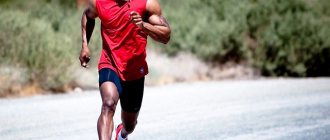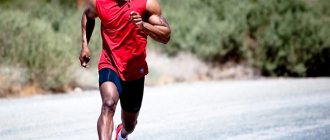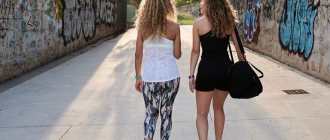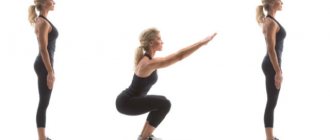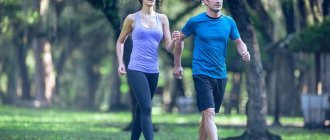How many kilometers can a healthy and fit person walk on foot in 8 hours? Can a person walk all day long without stopping? Such questions may arise when planning a tourist trip to another city or a hiking trip into nature. Or, for example, your car has broken down and you suddenly need to walk to the nearest populated area.
Although your body is designed to walk, the distance you can achieve at an average walking speed of 5 km/h depends on whether you have trained for it or not. A trained walker can cover the 42km marathon in eight hours or less; or walk 32 to 48 km per day. Steadily increasing your volume through training allows you to cover those longer distances with less risk of injury.
Navigation
- 10 km in 2 hours
- How long to walk without preparation
- Walking from scratch
- 32-48 km per day maximum
- 30 km or more every day
- Long and unexpected walk
Even beginners can easily walk 10 kilometers in two hours
10 kilometers can be walked in 2 hours if you haven't trained before.
Untrained walkers can enjoy a two-hour (~10km) walk at an easy pace, usually without any side effects. Proof of this is the charity 10-kilometer hikes of the Volksmarch, the American People's Sports Association. People who have not done any special walking usually do these walks without problems, although many find that they need good walking shoes after such long walks.
At what speed should you walk?
Walking speed, like walking distance, is an individual indicator. If you go simply for internal satisfaction, then speed is not important. If the goal is to lose weight by walking, then the speed of movement should be such that the pulse (heart rate) is within the fat-burning threshold.
How to calculate fat burning heart rate
- The first step is to determine the maximum allowable heart rate value. To do this, you need to subtract the age from the number 220.
- The second step is to keep your heart rate at 65-75% of your maximum. For example, if you are 31 years old, your maximum heart rate would be 220-31=189 beats per minute. 65% of 189 would be 123 or 142 if you take 75%.
- By targeting a heart rate of 123-142 beats per minute, you will be in your optimal fat-burning zone. But this method is not suitable for people whose heart rate differs from the norm, which for an adult is 60-90 beats per minute at rest.
But you should know that during aerobic exercise, which includes walking, the body begins to burn fat only after 30-40 minutes of activity in the optimal fat-burning heart rate mode. First of all, fats from muscle tissue are used, and only then fat reserves. Plus, the number of calories consumed should be less than those expended, i.e. you need to watch your diet. And if the main goal of walking is to lose weight, then a simple evening promenade at a leisurely pace will not help you lose excess weight, but it will certainly lift your spirits, improve sleep and well-being.
How long can you walk without training?
Wearing the right walking shoes is key to keeping your feet healthy.
Walking 16 km (more than three hours), even if you are used to walking 10 km, is a more challenging task. You can go this route, but most people will end up with foot problems such as blisters and calluses. Shoes and equipment that worked for two hours may not work for four hours. Blisters on your toes, heels, and ball of your feet show where your shoes and socks are not making proper contact with your foot. You may also develop irritation in the armpits, under the breasts, and in the perineum when sweat forms salty crystals. Using special anti-irritation creams will help protect your skin, strengthen your legs and slightly increase your walking time.
How long does it take to walk ten thousand steps?
The time it takes to walk ten thousand steps is determined by a person's speed and endurance. It is believed that on average you can walk 5 km in an hour. Thus, it takes on average 12 minutes to walk a kilometer. Calculate, taking into account your step length, how many kilometers your ten thousand are, and multiply by this value.
For example, if you have approximately 8 km for 10,000 steps, then this will take a little more than 1.5 hours. To get through the required number faster, you can consider the following recommendations:
- Vary your pace . Intensive walking helps you cover the required distance faster and burn more energy. But if you can’t keep up with this rhythm for a long time, try changing the pace, slowing down periodically - this way you’ll walk further and won’t get tired.
- Include distances in your usual route . Try walking a couple of stops instead of using public transport, and you will be able to reach the desired number faster.
- Train your body in general . The better your physical shape, the faster and easier it will be to walk long distances.
You need to walk in comfortable shoes and clothes. Nothing should interfere with your movements.
Walking time from kilometer to marathon distance
You should steadily increase the volume of distance traveled, and not jump from one volume to another. When training for a 21km half marathon or 42km marathon, try to increase your volume each week by 1.6km per week or 3.2km every two weeks.
Constantly work on the volume of your walking, increase it
An amazing training effect occurs. Nineteen kilometers may have seemed very difficult when you first reached this distance. But after six weeks, when you walk 29 km a day, 19 km will seem extremely easy and will not strain you at all.
Run
During running, almost the same body movements are performed as when walking, but there is a flight phase (moments when the legs do not rest on the surface), and leaning on two legs at the same time is excluded.
As you run, the gravity of the earth is rhythmically overcome and your blood flow resonates with your running.
This allows all capillaries to be filled with blood as much as possible, which improves the functioning of the entire body.
Based on the distance, running is divided into the following types:
- Run in place. Its effectiveness is significantly lower than classic running, but its clear advantage is the ability to perform it under any conditions. No rough terrain or stadium needed, one square meter is enough.
- Sprinting does not require much endurance, but the athlete's maximum dedication is important in order to reach the finish line as quickly as possible.
- The average distance is from 600 meters to 3 km. It is impossible to run a long distance at top speed. Therefore, the tempo is chosen to be slightly above average.
- The long distance is defined from 2 miles to marathon 42 km. It is better to jog for such a distance.
A healthy person can walk 32-48 kilometers per day
But how far can a trained person walk in eight hours? Many trained walkers complete the 26-mile marathon in seven hours without breaks. If the walker is well trained and takes breaks for food, then it is reasonable to cover 32 km per day. If you don't take breaks and walk quickly, you can cover 48 km per day if you steadily increase your exercise volume over three to six months.
Travelers on the month-long Camino de Santiago route typically walk between 19 and 32 km per day through difficult terrain that includes many hills.
Human stride length
The average gait length depends on factors such as gender, height, race, weight, gait (manner), and can range from 30 cm to 1 meter. But the average length has been determined: for a man it is 0.76 m, and the average length of a woman’s step is 0.67 m.
Each person's step is approximately the same size. There is a formula for determining the average step length depending on height .
Length.W = P:4 + 0.37
where: L.W – step length (m),
P – height.
Thus, the average step of a person 1.79 m tall is:
Length.W = 1.79: 4 + 0.37 = 0.82 m
In practice, the length of a person's step can be measured empirically . To do this, you need to measure out a section 10 meters long and walk along it, counting the number of steps. Then divide 10 m by this amount, and we get the length of one.
Let's say a pedestrian took 13 steps in 10 meters. We get:
Length.W = 10: 13 = 0.77 m
Important! In the Soviet Union, the average step length was determined. It was 1.5 meters in two, or 3 meters in four steps.
Walk 30 km or more day after day
Do you plan to walk for eight hours a day, such as walking in nature or walking around the city? Those who have walked such distances have had a lot of problems with calluses and blisters on their feet in the first couple of weeks, but then you either give up walking such long distances or cover 30 km or more every day with ease.
You can walk more than 30 km a day if you constantly train
If you're planning a big hike, you need to practice before you go, otherwise you'll be in for a hell of a time in the first few days in the form of blisters and calluses on your feet, body irritations, muscle pain and even stress. Unfortunately, on forums for hiking fans you will see advice that beginners can start hiking with theory. This is bad advice - practice is always better than theory.
Why you need to walk
Let's look at a few good reasons to be convincing:
- Walking is an aerobic form of physical activity, in other words, the same sport as running, swimming, fitness, etc.
- Walking helps strengthen muscle tissue and improves the functioning of the cardiovascular system.
- When walking, the level of stress resistance , mood improves, and sleep normalizes.
- While walking, the risk of injury is extremely low.
- Walking helps burn calories .
- Walking is accessible and easy.
- Suitable for people of all ages and has virtually no contraindications.
- Walking does not require special training or equipment.
- The risk of developing a number of serious diseases, such as diabetes , atherosclerosis, glaucoma, osteoporosis, etc., is reduced.
Pedometers
There are several types of them.
One is a fairly simple program that is installed on your phone or other device in your pocket and counts your steps.
We recommend that you set your personal parameters before launching it: weight, age, step length and may ask for your height.
Where can I get such a pedometer program for my phone for free?
In Google Play, their range is quite wide, so choose the one that is most comfortable for you and does not consume too many phone resources.
An ideal pedometer program is one that counts correctly, is low-resource, constantly shows how many steps you have taken even without turning it on, hangs in the tray and reflects the number of steps and calories.
Here are several photos of such programs with different numbers and results.
Secrets of this program:
- When you use transport, turn it off, otherwise it counts, and you don’t make any effort.
- Turn it on and off in the mornings and evenings to save battery power as much as possible.
- There are built-in pedometer programs, for example, in the myfitnesspell application, but for its constant operation you need the Internet, which is not always convenient.
- Set up the program so that it evokes positive emotions in you and for greater accuracy, take your phone with you at work or when you go to another office, so it will be more accurate.
- As practical experience has shown, a person weighing 95 kg takes about 12,000 steps per day, which is approximately 2 hours of walking, and burns approximately 547 kcal.
- Test 2-3 pedometers at once, the one you like the most and will be accurate, as well as low-battery, and leave that one.
There are also fitness trackers with a pedometer. In principle, a pedometer can even be built into a radio receiver.
What's your number?
For example, a 33-year-old man weighing 235 kg is recommended to take 4,000 steps a day in the first stage of weight loss.
The program “I’m Losing Weight on NTV,” where, with the help of walking and changing diet, a man lost 47 kg in 4 months:
For mothers on maternity leave, who are confined to the home and weigh up to 100 kg, the approximate figure could be 10,000 steps - that’s about 5 km. 1 step = 0.5 m, but such steps are not very suitable for weight loss.
Drink and food
- Water - in my opinion, mineral, slightly carbonated water is better. Drink a small sip every 10-15 minutes. Dehydration leads to rapid fatigue. I always had a half-liter bottle of water with me; it was hard to carry more. It’s great to have a thermos of herbal tea and additional tea leaves for it. You can ask for boiling water at any roadside cafe or at a rest stop to fill it with hot tea.
- Food – carbohydrates are everything. Simple and complex. One of the simple ones is glucose, sold in pharmacies. One of the more difficult ones is oatmeal with raisins, it takes longer to digest, but you go further, and your stomach isn’t so sad
- Dried fruits and nuts are a concentrate of vitamins, minerals and other benefits. I used the recommendation of experienced travelers - honey, walnuts, dried apricots, raisins, sesame seeds, lemon. In equal parts. Grind in a blender or simply cut into small pieces. Very tasty, both with porridge and tea.
- Fruits - bananas and apples, whatever is convenient to eat on the go.
- Special means - bee pollen (3-4 teaspoons per trip) and garlic cloves. I don’t know the method of action, but it becomes easier to move.
- For athletes - gels, bars and other doping

Apps that count steps
There are a lot of them. We offer you a brief overview of interesting applications.
Accupedo Pedometer. Pedometer and that's it. There is nothing more to say. But it provides a widget that shows the current number of steps, calories and distance on the screen.
Noom Walk. Stylish and simple interface. The app doesn't ask much. It can also tell your friends about your walking progress and get their ratings.
The M7 coprocessor, which constantly counts your steps and your activities, stores all this somewhere in the depths of your iPhone. You can remove some settings if you get tired of your device spying on you.
Fitbit. The app will count your steps if you walk with your phone in your hand or pocket. All your information about steps goes into MyFitnesspal and other worthy programs if you connect your Fitbit account in the settings. By the way, the application will count and compare your calorie consumption with the income from the food contributed to you. And he will take into account all the water he drinks.
Nike+ Move. This is for those who love Nike. The program, taking data on steps, makes them a measure of the coolness of Nike Fuel. Everything there is about burning fuel, and as you walk around, you also accumulate fuel points.
Breeze by RunKeeper. Nothing remarkable, it just counts steps, reports statistics, motivates users to use push notifications, etc.
Types of walking
For a general understanding, let’s mention the types of walking in order of least activity:
Health walking
A regular walk in any area. The duration of the movement does not matter. Average speed is 3-4 km/h. The maximum speed depends on the tasks and goals of the walker.
health path
A resort and recreational activity that involves a pre-planned route in mountainous areas. Speed, distance, number of ascents and descents are determined in advance. Typically, health paths are used for medicinal purposes and are carried out under the supervision of a doctor.
Nordic walking
A type of race walking using special poles. It is an independent sport. Almost 90% of the muscles are involved in the process of Nordic walking. Much more effective than healthy walking. The duration and speed of movement are individual.
Race walking
An Olympic sport that uses a special technique of movement along a distance. The speed of movement in race walking is from 6 to 15 km/h. The distances of the courses in this discipline depend on the age, gender of the athlete and the location of the competition (stadium or highway). Usually it is 3, 5, 10, 20 or 50 km.
Calculate calorie consumption based on heart rate
10,000 steps a day for health and weight loss
Energy expenditure can be calculated using your pulse. There is a formula for this:
E = 0.002 x M x T x (P - PP), where:
E — energy consumption, kcal;
M is the mass of a person, kg;
T — walking time, minutes;
PP – resting heart rate;
P - heart rate in motion.
For example, a person weighs 65 kg. He covered the distance in 10 minutes. Pulse in motion - 92 beats/min, at rest - 65.
This means: E = 0.002 x 65 x 10 x (90 – 65) = 35 kcal.
This calculation does not give accurate results, since it does not take into account the degree of physical fitness of the walker. With the same load, people with greater endurance have a lower heart rate.
We recommend videos on the topic:
The benefits of walking
A sedentary and mostly sedentary lifestyle leads to excess weight, the development of chronic diseases and even depression. Regular walking helps to increase the load without special exercise equipment and devices - on flat and rough terrain, uphill, up stairs.
Proper walking with monitoring of breathing and heart rate, adhering to safety precautions, has a beneficial effect on the condition of the human body:
- posture is straightened;
- movement coordination improves;
- the cardiovascular and respiratory systems are trained;
- lymph outflow accelerates;
- the body's resistance to colds increases;
- indicators of muscle strength and endurance increase;
- excess fat deposits are burned.
Movement increases the speed of metabolic processes, resulting in natural detoxification of the body. Walking at an average pace stimulates the production of endorphins - joy hormones that improve your psycho-emotional state.
Equipment. Of the vital...
- The backpack is comfortable, with waist and chest straps. One of the must-haves is that it should have side pockets so that it is convenient to get a bottle of water without removing the backpack.
- A penknife and a lighter were not useful to me, but cases vary.
- A seat mat - you can sit anywhere and on anything It’s less work for your head, where to sit your own butt.
- A smartphone with GPS and an additional external battery for it. My iPhone 5, working only with the Runkeeper program, was ready to sit down in 10-11 hours. And orientation to the area and understanding how far it is to the nearest rest stop or populated area can be really important.
- Medicines and patches. Muscles and ligaments will hurt - painkillers such as paracetamol, ibuprofen and muscle ointment. There will be calluses too - apply plasters in advance!
- Headlamp. The manual one is inconvenient, although it wouldn’t hurt to have it as a spare. A set of spare batteries.
- Phones, preferably two, and working with different operators.
Registration
I registered for 100 sq.m. 2 weeks before the start. Registration was quick and easy - you were given a card, a personal card for marking checkpoints, a list of emergency telephone numbers and two numbers in a reflective frame. The entry fee was only 50 hryvnia - victorious communism in its purest form 
A week before the start, the main task is to get enough sleep and reduce the training load to a minimum. It turned out well.
Day before the start. General recommendations are to take a day off, relax and regroup. I didn’t manage to rest, I started getting ready at 6 pm and managed to get ready by 12 am. Conclusion - you need to start earlier.
The night before the start. I slept well. If you can't fall asleep, it's okay - the previous week of good sleep will compensate for everything.
Morning before the start. Wake up, shower, pray, exercise, hearty breakfast, final check to see if everything is packed. Taxi - and here I am at the start!
Pre-launch registration was even easier. You call your number and receive a mark on your personal card about the start. Many thanks to the organizers - there was an opportunity to transfer things and food to any of the checkpoints. There were four in total at kilometers 15, 46, 55 and 79. I handed over warm clothes to KP-46, which is where, according to calculations, I was supposed to reach in the evening.
Half an hour before the start - a small official part, words about the heroes of the Great Patriotic War, wishes of good luck and some advice from the winner of the first hundred square meters: go up the hill, run down the hill, don’t stay long at rest stops.
So, 15 minutes before the start, final preparations, runners are warming up.
The number of participants is 414 people (315 men and 99 women) and the Siberian husky Lada, with its own number 51.
In general, Sotka is a cult event for Odessa, where you can see professional marathon runners, politicians, avid tourists, students, young people from Christian organizations, the Odessa Bearded Club and many, many others. Some prepared in advance, while others decided to go only the day before. Perhaps, I especially remember the guy in knight's garb, who walked about 30 kilometers in it.

